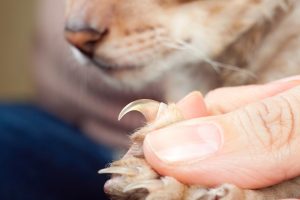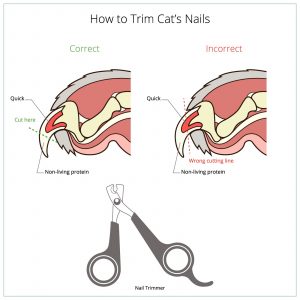By the PPG Cat Committee

Cats’ experiences with claw trims are often far from positive, which can result in them not liking the process © Can Stock Photo/aksakalko
While there are a lot of cats who may not initially be terribly keen on the whole claw trimming process, there are ways to make it enjoyable and fun for both parties. This article will explain the steps cat owners can take to make it a more pleasant, stress-free experience all round.
Important Reminders:
- Trimming a cat’s claws can prevent damage to furniture and other household items, as well as to humans, from inadvertent scratches.
- Often the biggest challenge isn’t the claw trimming itself but teaching the cat to become comfortable with having his paws handled.
- The goal is to gain the cat’s cooperation with the procedure, not to figure out the best restraint method.
- There is no need to trim all the claws in one sitting; our impatience to get this done often makes the procedure stressful and unpleasant for the cat.
Safety Information:
- Cats’ claws have a narrow hook at the end and a wide base with a pink middle called the quick, which contains blood vessels and nerves. The narrow hook part is the part to cut. Avoid cutting the quick, as it will bleed and cause pain. When trimming your cat’s claws, gently squeeze the toe pad to extend the claw and identify the quick so you can avoid nicking it. If you do cut into the quick by accident, you can stop the bleeding fairly quickly with a styptic powder.
Techniques and Tips:

© Can Stock Photo/AlexanderPokusay
- Be patient and prepared: Take a deep breath and be gentle and calm. Prior to starting, purchase specific cat claw trimmers that are comfortable to handle, are rubber coated to avoid slipping, and have a stainless-steel blade.
- Make it positive: Cats’ experiences with claw trims are often far from positive, which results in cats not liking the process. Before starting, get some delicious, extra special treats your cat only gets during claw trims. A few examples are canned food, freeze-dried meat treats, tuna fish, and anchovy paste. You can also pet your cat in his favorite spot, brush him, or engage in a play session afterward, depending on his preference.
- Get comfortable: Trim your cat’s claws in a quiet room without distractions. It is important to provide a non-slip surface, like a yoga mat, for your cat to stand on. It can be helpful to trim the claws with the cat on an elevated surface (such as a table or a dresser). Do not restrain the cat—many cats dislike being turned on their back or restrained on their side, or even held in your lap. Instead, support and guide the cat’s body and paws. The cat should willingly participate because you have tasty treats. When choosing a time to trim claws, it is best to do it when your cat is relaxed, and not during play, for example.
- Start slowly and take it one step at a time: Feed the cat a special treat and trim one claw at the same time. Make sure the cat is engaged in eating the treat before trying to touch his/her paw. If your cat stays relaxed, then trim a second claw while the cat continues to eat. As soon as the cat stops eating the favorite treat and/or starts fussing, the activity ends. The first few times you trim the cat’s claws, you might get the claws on only one paw trimmed, or even only one or two claws. That’s fine! Just make sure it’s a good experience for the cat. The next time you do it, the cat will be more willing to participate, and it will progress from there.
- Ask for help: If your cat continues to be resistant to claw trimming or to having his paws handled, a qualified training specialist can help you teach him to accept and even enjoy nail trims. A Fear Free certified (https://fearfreepets.com) or Cat Friendly (https://catvets.com) veterinary hospital can also help.
Specific tools:
- Claw trimmers. Stainless-steel scissors-type cat claw trimmers (two half-circle blades) with rubber-coated handles are recommended.
- Treats, a cat brush, cat toys.
- Non-slip surface (e.g., yoga mat).
Timeline:
- Approximately two to four weeks but may take more—or less—time, depending on the individual cat.
A printable PDF version of this document is available as a handout on the PPG website: https://petprofessionalguild.com/Trimming-Claws
Note: Every cat is an individual, and behavior is complex. If you need help training your cat, please seek out
a qualified feline behavior professional: https://petprofessionalguild.com/Find-Your-Feline-Professional
© 2019 The Pet Professional Guild Feline Committee
